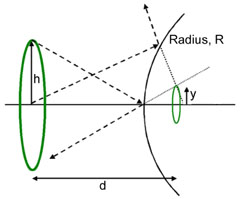Optipedia • SPIE Press books opened for your reference.
Keratometry
Excerpt from Field Guide to Visual and Ophthalmic Optics
Keratometry is the measurement of the corneal radius of curvature. The anterior corneal surface is treated as a specular reflector. A ring of known size is placed in front of the eye. The cornea (in reflection) forms a virtual image of the ring below its surface. The virtual image is the first Purkinje image of the ring.  The size of this image is related to the radius of curvature, R, of the cornea by R = 2dy / h, where h is the radius of the ring object, y is the radius of the ring image, and d is the distance between the object and image. In converting the corneal radius to corneal power it is customary to use the keratometric index of refraction nk = 1.3375, instead of the actual index of refraction of the cornea. The keratometric index is an effective index that accounts for the negative power introduced by the posterior corneal surface. Consequently, keratometry attempts to predict the total corneal power based only on a measurement of the anterior corneal surface. The corneal power in diopters is given by Φ = 337.5 / R, for R in mm.
The size of this image is related to the radius of curvature, R, of the cornea by R = 2dy / h, where h is the radius of the ring object, y is the radius of the ring image, and d is the distance between the object and image. In converting the corneal radius to corneal power it is customary to use the keratometric index of refraction nk = 1.3375, instead of the actual index of refraction of the cornea. The keratometric index is an effective index that accounts for the negative power introduced by the posterior corneal surface. Consequently, keratometry attempts to predict the total corneal power based only on a measurement of the anterior corneal surface. The corneal power in diopters is given by Φ = 337.5 / R, for R in mm.
When corneal astigmatism is present, the ring image becomes elliptical. The major and minor axes of this ellipse define the orientati of the corneal astigmatism. In this case, keratometry is normally measured along these two orthogonal meridians, giving the maximum and minimum corneal power. These extrema are known as K-values or corneal Ks. The difference between the K-values is a measure of corneal astigmatism. With-the-rule astigmatism is when the vertical meridian is steepest (smallest radius). Against-the-rule astigmatism is the converse case. Irregularities in corneal shape cause further distortion of the ring image, providing a subjectively assessment of corneal shape.
J. Schwiegerling, Field Guide to Visual and Ophthalmic Optics, SPIE Press, Bellingham, WA (2004).
View SPIE terms of use.

